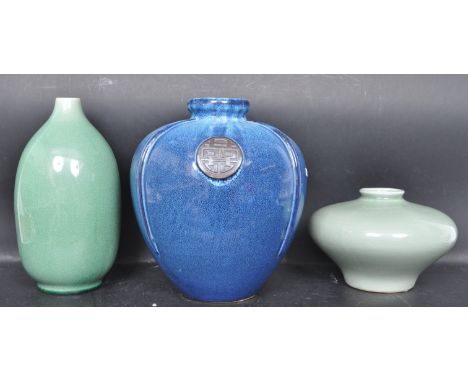We found 163696 price guide item(s) matching your search
There are 163696 lots that match your search criteria. Subscribe now to get instant access to the full price guide service.
Click here to subscribe- List
- Grid
-
163696 item(s)/page
A collection of vintage 20th century ceramic porcelain cabinet ware to include a Poole pottery fish, two Beatrix Pottery “ Mr. Alderman Ptolemy “ and “ Goody Tiptoes “ USSR ceramic bird, Royal Doulton - Merlin Whyte & Mackay Scotch whisky decanter, Haddon Hall Minton vase. Measures 19cm tall.
A collection of vintage 1930s Art Deco ceramic kitchenalia to include a Kirkham pottery three jar set, two being labelled for Flour and Soda, the third being unmarked, all with painted green decoration to the lids. Together with a G Rushbrooke of Smithfields ham stand. Flour jar measures 20cm tall.
Rolls-Royce bundle- one crystal whiskey glass, one ceramic mug and one 'Friendly Burlington Arcade London' chrome decanter, in the form of Rolls Royce vertical slat radiator with a miniature 'Spirit of Ecstasy' mascot fitted to the screw top 18 x 12cm.Condition Report: Decanter appears to have slight internal damage.
Antique Chinese glazed ceramic storage urn, late Song to Yuan Dynasty (circa 13th century), with Qingbai glaze, height 67cmUrn has been authenticated by P L Combs, there is glaze crazing around the top rim, generally in very good condition, with a few chips around the unglazed part of the foot
A 19th Century Dutch Delft blue and white ceramic miniature clock in the form of a longcase grandfather clock. The ceramic case having floral and patterned decoration throughout with central scene to the trunk of a wondering gentleman seen raising his drink glass to the sky. White face with Roman numeral chapter ring. Wear commensurate with age with some minor chips. Measures approx; 44cm tall.
Matisse on the Chapelle du Rosaire de Vence MATISSE HENRI: (1869-1954) French Artist. An important typed manuscript, with extensive manuscript additions by Matisse, unsigned, one page, folio, n.p. (Vence), n.d. (c.1950), in French. The typed manuscript, evidently prepared by a journalist following an interview with the artist, is entitled An Hour with Matisse, and provides details of Matisse's work at the Chapelle du Rosaire de Vence as it reaches its final stages of decoration, explaining that the eminent architect Auguste Perret has supervised the project, and that Matisse's studio is currently a replica of the chapel's interior with a huge amount of drawings affixed to the walls, many in yellow, green and blue, representing the colours to be used in the stained glass, further describing the position of the altar, the white marble floor, and the black and white ceramic tiles which Matisse is creating. The manuscript continues with several questions posed to Matisse, which he responds to in his own hand, explaining that the square ceramic tiles are to be decorated in black and white in order to strike a balance with the colours of the stained glass, and expressing his view that the hardest challenge in building and decorating the chapel was to fill a relatively small space with the monumental and expressive concept that he wished to achieve. Matisse also states that he has not felt the need to change his religious views in order to create the chapel, and that all of his life his work has been made with the religious feeling of the mystery of nature. Finally, the artist remarks that he has not had time to consider future projects as the chapel has not yet been completed. The final third of the page was originally part of a separate sheet and is now neatly affixed to the base of the primary sheet. VG In 1941 Matisse, living in the south of France, developed cancer and underwent surgery. During his long recovery he was assisted by a young nurse, Monique Bourgeois, who also served as a model for several of the artist's drawings and paintings. In 1943 Bourgeois entered the Dominican convent in Vence and became Sister Jacques-Marie. In due time Matisse bought a house in Vence and remained in touch with the young nun. She told him of the plans the Dominicans had to build a chapel and sought Matisse's help with the design of the building. Matisse agreed and the project commenced in 1947. Over the next four years the artist worked on the chapel, its architecture, stained glass windows, interior furnishings, murals, and the priests' vestments. The chapel features three sets of stained glass windows which Matisse dedicated much of his time to. All three sets make use of just three colours: an intense yellow for the sun, an intense green for vegetation and cactus forms, and a vivid blue representing the Mediterranean Sea, the Riviera and the Madonna. For the walls Matisse designed three murals to be made by painting white tiles with black paint and then firing the large sections of tile. Although Matisse had been baptised a Catholic, he had not practised the religion for many years. The artist had never undertaken work of the kind before, and upon completion Matisse himself declared the chapel to be his 'masterpiece'.
A pair of early 20th Century James Stinton for Royal Worcester ceramic plaques being set within hallmarked silver trinket dishes. The plaques being hand painted with pheasants, the dishes having moulded gadrooned rims. Hallmarked Birmingham 1912, makers marks for Sanders & Mackenzie. Both measures 8.5cm diameter. Weight 109.4g. Puce marks to the verso.
A collection of vintage costume jewellery to include a selection of mid century including stone set examples, a glass bead and white metal necklace, a Limoges ceramic brooch, a wide selection of beaded necklaces, yellow metal chain necklaces, micro mosaic bracelet, yellow metal collar necklace and simulated pearl necklaces.
A rare Copeland parian bust of 'The Mother', dated 1874Modelled by Raffaele Monti, her head tilted to her right gazing towards the sleeping baby held close, her fine headscarf draped gently over the child, its face and curls just visible through the drapery, on a socle, 37.2cm high, impressed COPELAND, CERAMIC AND CRYSTAL PALACE ART UNION, incised R Monti 1871Footnotes:'The Mother' was issued as a companion to 'The Bride'. See lot 464 in this sale for an example of the latter. Both busts are illustrated by Paul Atterbury (ed.) The Parian Phenomenon (1989), p.180, fig.586.For further information on this lot please visit Bonhams.com
An important Worcester centrepiece, circa 1755Of deep oval form, the exterior crisply moulded with basket-weave, the two braided handles applied with flowers and leaves at the terminals, the centre finely painted in blue with the 'Six-Piered Bridge' pattern (I.B.33), a fisherman and a young boy crossing the bridge connecting two islands, varied buildings perched on the rocky landscape, trees sprouting between them, more fishermen steering their sampans through the water, 36.7cm wide across the handles, workman's mark inside footrimFootnotes:This rare basket is one of just a small number of extant examples, the others mostly in poor condition. One is illustrated in Branyan, French and Sandon, Worcester Blue and White Porcelain (1990), p.131 and was sold as part of the Crane Collection by Bonhams on 31 March 2010, lot 95. Another was in the Liane Richards Collection, sold by Bonhams on 13 April 2016, lot 161 (part). A fine example is in the Radlett Collection and can be seen in the Gardiner Museum of Ceramic Art, Toronto, no.G05.18.35. The present lot has a more elaborate border, which is all the more impressive for its clarity and detail when comparing it with contemporary less successful and blurred attempts on other high-sided shapes. Interestingly, the same workman's mark can be found on the pair of junket dishes, lot 400 in this sale.This lot is subject to the following lot symbols: ** VAT on imported items at a preferential rate of 5% on Hammer Price and the prevailing rate on Buyer's Premium.For further information on this lot please visit Bonhams.com
-
163696 item(s)/page




























































